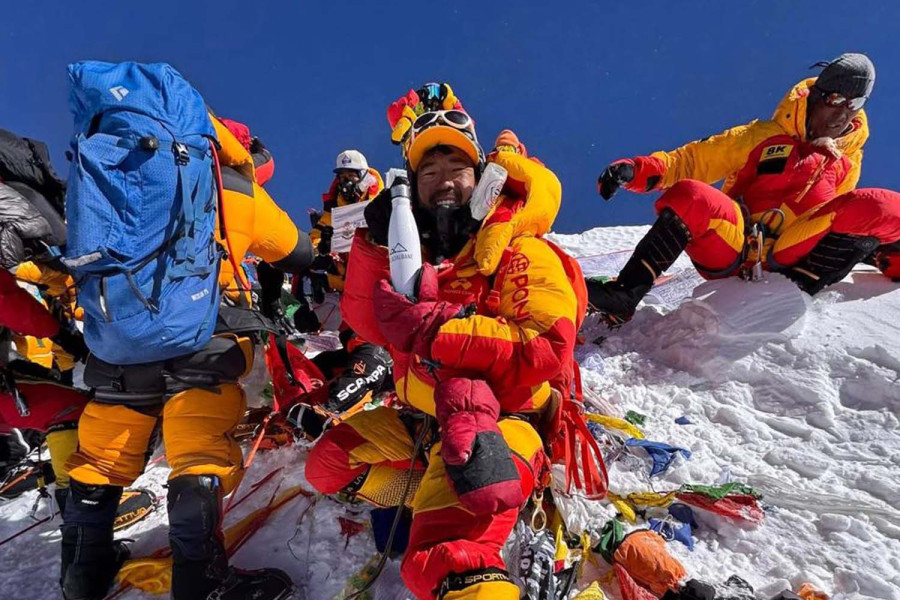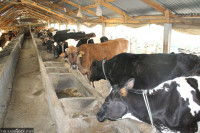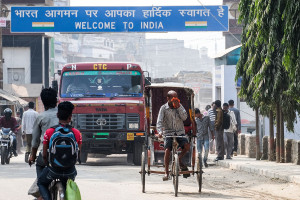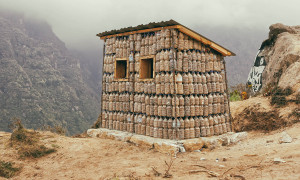Money
Sherpa rewrites Everest history
29-year-old Tashi Gyalzen Sherpa stood atop Everest for the fourth time in just 15 days, redefining what’s possible at the planet’s highest elevation.
Sangam Prasain
In the pre-dawn silence of a Friday morning, while the world below still slept, a 29-year-old man from a quiet Khumbu village stood atop the world’s highest mountain—for the fourth time in just fifteen days.
Tashi Gyalzen Sherpa had once again conquered Mount Everest, gasping in the oxygen-thin air at 8,848.86 meters. It was 3:13 am.
No one had ever done this before. He didn’t just race against time—he redrew the boundaries of what the human body and spirit can endure in the planet’s harshest extremes.
Born in Phortse, a village where nearly every household has produced a climber, Tashi grew up surrounded by snow, altitude, and the legacy of Everest. His father, Ang Chhiring, once laboured as a porter, hauling heavy loads through the perilous trails to base camp. In Phortse, mountaineering isn’t just a profession—it’s heritage, necessity, and sometimes, destiny.
Tashi answered that call in 2017, starting his career as a trekking guide.
Two years later, in 2019, he stood on Everest’s summit for the first time. Since then, he has reached the peak three times from the Nepal side and once from the Tibetan side. But this spring, he achieved something even the world’s most seasoned mountaineers once deemed impossible.
He summited Everest four times in fifteen days.
His historic climb began on May 9 as part of the rope-fixing team laying the route for others. That was his first summit of the season. He reached the top again on May 14, then May 19, and finally, May 23—for the fourth time.
“This is a world record and a new limit of human endurance,” said Pemba Sherpa, executive director of 8K Expedition, the agency Tashi represents. “He aimed to do it within twenty days—but finished in fifteen. It’s unbelievable.”
To those who know the mountain, it wasn’t just the number of ascents that was astonishing—it was the rhythm. After each summit, Tashi descended to rest and to recover. And then, he climbed again. And again. And again.
His fellow climbers were in awe. “Huge congratulations for achieving the unimaginable—summiting Everest four times in just 15 days!” wrote Chepal Sherpa, a colleague, in a heartfelt Facebook post. “Your strength, skill, and unbreakable spirit have set a new world record and inspired millions. You’ve not just climbed mountains—you’ve moved them. Proud of you, brother!”
Tashi’s story is one of grit, resilience, and deep-rooted tradition. Like many Sherpas, he turned to the mountains to support his family, not for glory. In Khumbu, guiding climbers on Everest is more than a job—it is the region’s economic lifeblood and cultural identity.
He is scheduled to return to base camp on Saturday and to Kathmandu on Tuesday. From the world’s highest point, he descends to no fanfare or medals—but to a life of quiet dignity, the kind Sherpas have lived for generations.
Over the years, Tashi has summited other formidable peaks, including Cho Oyu, Manaslu, and Ama Dablam.
His achievement follows a growing trend of record-breaking feats on Everest. Last year, Dawa Phinjhok Sherpa summited Everest three times in just eight days. Among women climbers, photojournalist Purnima Shrestha made headlines for her triple summit in a single season.
“Tashi represents a new generation of Sherpa climbers—guides, record-breakers, storytellers, and trailblazers,” said Ang Tshiring Sherpa, a mountaineering expert and former president of the Nepal Mountaineering Association. “They are climbing in the era of technological advancement. The world is now connected through smart devices, which, among other things, has even made Everest climbs faster.”
On May 19, American climber Andrew Ushakov made history by becoming the fastest person to ascend from sea level to the summit of Everest—just three days, 23 hours, and seven minutes.
Ushakov began his journey in New York at 12:30 am on May 15, flew to Kathmandu, and then helicoptered to base camp before making his ascent. He reached the summit by 9:22 am on May 19, completing the climb in under four days, shattering expectations.
“That’s a win not just for me, but for people who want to enjoy mountains without making major sacrifices to their work or families,” said Ushakov. “With proper preparation, climbers can make faster ascents, spend more time with loved ones, and reduce environmental impact.”
Previously, Roxanne Vogel held the sea-to-summit record with a 12-day climb in 2021.
Meanwhile, four former British special forces soldiers have stirred controversy with their rapid ascent of Everest in under five days, bypassing traditional acclimatisation. Nepali authorities have raised concerns not about the speed of their climb, but the use of xenon gas, allegedly taken before arriving in Nepal.
“From one angle, it’s an extraordinary feat,” said Ang Tshiring Sherpa. “But it also breaks traditional mountaineering norms—the values of challenge, patience, and respect for the mountain. Without those, what’s left?”
Nepal issued 468 Everest climbing permits this spring, each priced at $11,000. The race to the summit has grown increasingly crowded, commercialised, and competitive. Yet amid the frenzy, one Sherpa’s story rises above it all.
Four summits. Fifteen days. A singular, staggering achievement. Tashi Gyalzen Sherpa didn’t just climb Everest—he transformed what it means to face the mountain.




 10.12°C Kathmandu
10.12°C Kathmandu















